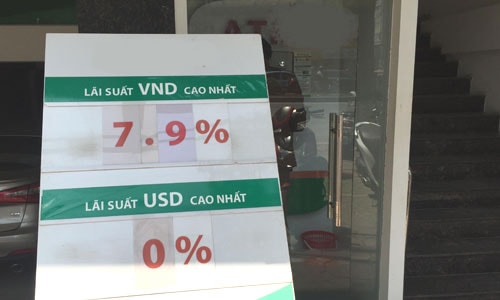Banks' 'counting chickens before their losses' profits
Accrued interest - money not yet received but still accounted for to create profit - is growing larger and larger, which is the reason why many banks are having to use newly mobilized money to pay interest on old deposits.
The 2015 financial market overview report of the National Financial Supervisory Commission, published on March 14, mentioned a risk that the market faces with a relatively small capacity: The scale of interest receivables from newly restructured banks is relatively high. This is considered a major risk that the system is facing, after the bad debt story was temporarily handled.
To clarify this issue, Vice Chairman of the Financial Supervision Committee Truong Van Phuoc said that accrued interest is an amount that has not been collected yet, but according to the accounting regime, banks still include it in creating profits. There are banks reporting profits of thousands of billions, but in reality, the accrued interest (not yet collected) is very large, accounting for tens of percent, proving that their profits are not real.
 |
| While interest on deposits has been paid to customers, interest accrued on loans from banks is increasing day by day. |
Agreeing with the Supervisory Committee, Mr. Nguyen Xuan Thanh - an economic expert of the Fulbright Economics Teaching Program - also said that not only weak banks are restructuring, many medium-sized banks are also recording more and more uncollected interest. According to Mr. Thanh, the consequence is that when looking at the cash flow, while the interest on deposits for people has been paid, the interest on loans has not been received. According to 2015 data, the NIM profit margin of banks is about 2.74%. Mr. Thanh said that this number is partly "virtual".
"Some banks are currently having to continuously mobilize new deposits to pay interest on old deposits and uncollected accrued interest. Besides having to continue to handle bad debts, how to resolve this accrued interest will put more pressure on banks," Mr. Thanh analyzed.
In fact, according to current accounting standards, if a medium- and long-term loan project is still in the investment phase, not yet operational, and cannot pay interest and principal, the bank is allowed to record it in interest income (accrued interest). Talking to VnExpress, the general director of a joint stock bank said that the reason for the high accrued interest is that banks lend to many large medium- and long-term projects that are still unfinished. "The higher the accrued interest, the more problems the projects have encountered, so they have not yet created cash flow for the bank. Most of the State's public investment projects with large works are 'stuck' in this case," he said.
However, he said that the ratio of accrued interest to total assets is acceptable if it is around 5-7%. "In reality, if the project is prolonged, accrued interest will arise, creating a potential burden for the bank. If the project fails, in addition to having to make provisions for the loan principal, the bank will also have to make provisions for accrued interest," he said.
A senior leader of the Financial Supervisory Commission said he had reported to the Prime Minister the risks surrounding the increasingly large expected interest income of banks. Expert Nguyen Xuan Thanh also said that there should be a form of warning about this risk soon, although he admitted that naming individual banks might be prudent. However, he also noted that there are banks with expected interest income of thousands of billions of dong in a period, which is alarming.
According to VnExpress
| RELATED NEWS |
|---|



.jpg)




